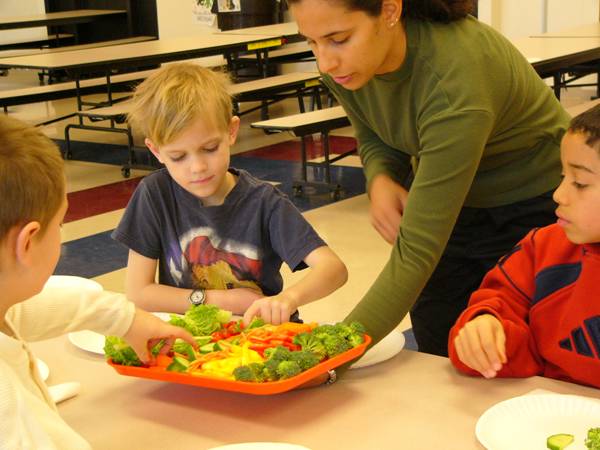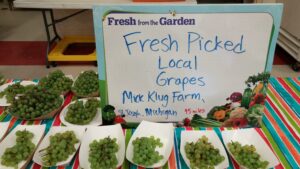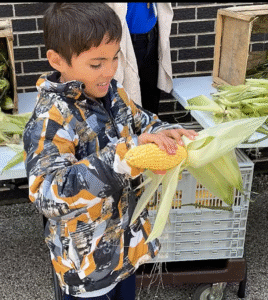
As the saying goes, it isn’t easy being green. But it’s gotten even harder in recent months. Federal funding cuts are hitting environmental programs across the country, and are taking their toll right here in Illinois, as well. Seven Generations Ahead (SGA) has always been committed to building a sustainable, local foodshed, and we remain steadfast in this work. But the decision in March to terminate USDA funding programs that support local food purchasing for schools will have far-reaching effects, with serious consequences for farmers and school food programs, and ultimately, all the children who depend on this funding for nutritious, local school meals.
In March, both the Patrick Leahy Farm to School grant program and the Local Food for Schools and Child Care (LFSCC) program were canceled. These USDA grant programs both provided critical funding for schools to be able to buy from local farms. The impact of this loss will be felt by the schools and the farmers that depended on this source of income, and by the students who will miss out on nutritious, local meals.
“These grants were designed to ensure that students in our schools and child care centers have access to fresh, locally-sourced food while also supporting our state’s agricultural economy,” said Illinois State Superintendent Dr. Tony Sanders. “This funding was essential to provide Illinois schools and child care sites with nutritious meals that fuel learning and growth.”
The LFSCC funding was supposed to be the second round of funding available for schools, and it expanded upon Local Food for Schools funding (LFS), which is still available to Illinois schools.
“Local Food for Schools Funding (LFS) has been an amazing opportunity for schools, farms and communities,” said Lindsay Blough-Mabie, who oversees Farm to Child Nutrition Programs for the Illinois State Board of Education (ISBE). She notes that in Illinois, the current LFS funding is available to schools through January 31, 2026 and ISBE encourages schools to utilize their full entitlement.
LFS funding is an important entryway into local procurement for many schools, and LFSCC funding would have expanded it to child care centers, while providing an additional runway for schools to participate in farm to school purchasing, which can be expensive and difficult to navigate.
“We’ve used LFS as a launchpad to introduce a Harvest of the Month program across 13 school districts, our ‘food in the door’ so to speak,” said Trish Bellmore, Executive Director of the Greater Wabash Food Council. “Since August, we’ve funneled nearly $10,000 directly into the hands of regional farmers. We’ve already started planning for the 2025–2026 school year, and farmers have seeds in the ground based on those plans. If funding gets pulled, the impact will be significant.”
LFS funding provides a critical pathway for schools to buy local. Not only is the financial support important, as the cost of local food can be prohibitive, but the program also provides much-needed education. Navigating local procurement can be a real barrier for schools wanting to buy from local farms.
“LFS is about learning how to buy local, how to make those connections,” said Diane Chapeta, SGA’s Senior Program Manager for the Illinois Farm to School Network (IFSN). “It’s about how it applies to the menus, what labor is involved in it, training the staff and teaching the kids.”
According to Blough-Mabie, because of LFS and LFSCC funding, schools have taken many steps toward buying local, including identifying local products to buy, developing recipes and modifying menus, training staff, connecting with local producers, and more. Farmers have built relationships with schools, learned how school food service programs operate, including the rules and regulations that schools need to follow and any purchasing requirements, and some have even modified how they’ve traditionally done things to accommodate school buyers. All this work, preparation, and planning could be a sunk cost for both schools and farmers without LFSCC funding to support it.
“Schools and farmers have forged relationships and partnerships. They were making plans for what the future of fresh local meals in schools and child care could look like for their community, their schools, and the local agricultural economy,” said Blough-Mabie. “Local food infrastructure takes time to build and supply and demand have to merge together at the right time in order for everything to come together.”
All the effort schools and farmers put into building this local food infrastructure is ultimately for the benefit of the students. School food programs are crucial for the many students who depend on them for reliable, nutritious meals. LFS funding allows schools to provide high-quality, healthy food to all students, using local ingredients that may otherwise be too expensive or challenging to access.
“This particular program has helped us to expose the students to new ingredients that are not traditionally introduced in the School Breakfast Program (SBP) and National School Lunch Program (NSLP),” said Allison Brown, District Manager for OrganicLife, a food management service that works with K-12 schools. “The LFS funding has been crucial in assisting us in building a bridge with the community we serve, as we are able to bring in exciting new offerings for their children to explore in the SBP and NSLP.”

Blough-Mabie says ISBE has surveyed schools on barriers to purchasing local food, and they identified time, cost, and not knowing where to start as the primary roadblocks. LFS funding went a long way to remove these barriers, and created an opportunity for ISBE, IFSN, and other partners like the Illinois Department of Agriculture and the Illinois Farm Bureau to create resources, trainings, and other ways for schools and farmers to connect. LFS funding has been transformational for the farm to school movement, and many schools and farmers were counting on LFSCC funding to help them continue with the work they’ve already started.
“Our schools have very tight meal program operation budgets, so they have to balance what they can afford with what they want their meal programs to look like,” said Blough-Mabie. “Buying local, working with local producers, and figuring out ways to budget local products is still a work in progress. Schools and farmers were continuing to learn about how to make local foods financially viable in school settings, and they need more time with the financial support of LFS and LFSCC to develop a plan that is sustainable for both parties.”
Chapeta says it’s hard to overstate how much the loss of LFSCC funding will set back the farm to school movement. It won’t be easy for schools and farmers to just go it alone without federal funding.
“The loss of the LFSCC funding is devastating for our Illinois students, farmers, ranchers, processors, distributors, communities and the local economy,” said Blough-Mabie.
Despite these recent funding losses, SGA is still working on building a sustainable, local foodshed through multiple other projects. As the Illinois state lead on the Lake Michigan School Food System Innovation Hub, which is supported by USDA funding that will remain in place, SGA is supporting farmers, distributors, and other food innovators throughout the state working to get nutritious local food into school cafeterias.
 The National Farm to School Network (NFSN) is providing the public with action alerts and updates on the federal funding and policy landscape. Individuals can visit NFSN’s Action Center for ways to speak out and support farm to school programs. And they have a new state policy handbook which can provide frameworks for advancing this work state by state. With uncertainty at the national level, state policy will become even more critical in the farm to school movement.
The National Farm to School Network (NFSN) is providing the public with action alerts and updates on the federal funding and policy landscape. Individuals can visit NFSN’s Action Center for ways to speak out and support farm to school programs. And they have a new state policy handbook which can provide frameworks for advancing this work state by state. With uncertainty at the national level, state policy will become even more critical in the farm to school movement.
SGA is still working with the Illinois State Board of Education on farm to school programs, and is still working with food hubs, farmers, and schools to help them connect in Illinois and across the region.
“We want people to know what’s happening and what it’s affected,” said Chapeta. “And we want people to know that SGA is still in the fight.”
Schools interested in pursuing the LFS funding that is still available through the end of January, 2026 should visit ISBE’s website. To access SGA’s farm to school resources through our IFSN program, visit the Illinois Farm to School Network website. And to stay up to date on farm to school developments at the national level, visit the National Farm to School Network website.
